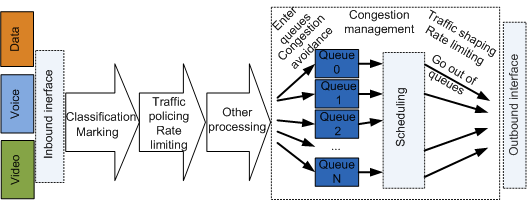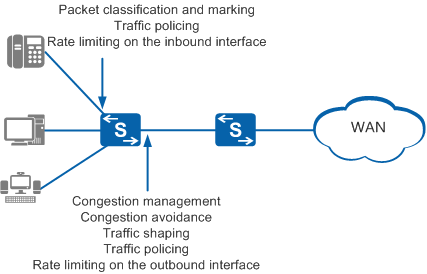Overview of QoS
QoS Background
Diverse services result in a sharp increase in network traffic, which may cause network congestion, increase forwarding delay, or even cause packet loss. Any of these situations will cause service quality deterioration or even service interruption. Therefore, real-time services require a solution to prevent network congestion. The best solution is to increase network bandwidth, but increasing network bandwidth is costly. The most cost-effective way is to use a "guarantee" policy to manage traffic congestion.
QoS guarantees end-to-end service quality based on the requirements of different services. It helps improve utilization of network resources and allows different types of traffic to preempt network resources based on their priorities; for example, voice, video, and important data applications can be processed preferentially on network devices. QoS is now widely used and plays an important role in Internet applications.
QoS Service Models
- Best-Effort
Best-Effort is the default service model for the Internet and applies to various network applications, such as the File Transfer Protocol (FTP) and email. It is the simplest service model, in which an application can send any number of packets at any time without notifying the network. The network then tries its best to transmit the packets but provides no guarantee of performance in terms of delay and reliability.
The Best-Effort model is suitable for services that have low requirements for delay and packet loss rate.
- Integrated Service (IntServ)
In the IntServ model, an application uses a signaling protocol to notify the network of its traffic parameters and apply for a specific level of QoS before sending packets. The network reserves resources for the application based on the traffic parameters. After the application receives an acknowledgement message and confirms that sufficient resources have been reserved, it starts to send packets within the range specified by the traffic parameters. The network maintains a state for each packet flow and performs QoS behaviors based on this state to guarantee application performance.
The IntServ model uses the Resource Reservation Protocol (RSVP) for signaling. The RSVP protocol reserves resources such as bandwidth and priority on a known path, and each network element along the path must reserve required resources for data flows requiring QoS guarantee. That is, each network element maintains a soft state for each data flow. A soft state is a temporary state that is periodically updated through RSVP messages. Each network element checks whether sufficient resources can be reserved based on these RSVP messages. The path is available only if all involved network elements can provide sufficient resources.
- Differentiated Service (DiffServ)
The DiffServ model classifies packets on a network into multiple classes and takes different actions for each class. When network congestion occurs, packets of different classes are processed based on their priorities, resulting in different packet loss rates, delay, and jitter. Packets of the same class are aggregated and sent as a whole to ensure consistent delay, jitter, and packet loss rate.
In the DiffServ model, traffic classification and aggregation are completed on edge nodes. Edge nodes classify packets based on a combination of parameters in packets, such as the source and destination addresses, precedence in the Type of Service (ToS) field, and protocol type, and then mark packets with different priorities. Other nodes only need to identify the marked priorities for resource allocation and traffic control.
Unlike the IntServ model, the DiffServ model does not require a signaling protocol. In this model, an application does not need to apply for network resources before sending packets. Instead, the application sets QoS parameters in the packets, through which the network can learn the QoS requirements of the application. The network provides differentiated services based on the QoS parameters of each data flow and does not need to maintain a state for each data flow. DiffServ takes full advantage of IP networks' flexibility and extensibility and transforms information in packets into per-hop behaviors (PHBs), greatly reducing signaling operations. DiffServ is the most commonly used QoS model on current networks. QoS implementation described in the subsequent sections is based on this model.
Mechanisms in the DiffServ Model
The DiffServ model involves the following QoS mechanisms:
Traffic classification and marking
Traffic classification and marking are prerequisites for differentiated services. Traffic classification divides packets into different classes or sets different priorities, and can be implemented using traffic classifiers configured on the Modular QoS Command-Line Interface (MQC). Traffic marking sets different priorities for packets and can be implemented through priority mapping and re-marking.
Traffic policing, traffic shaping, and interface-based rate limiting
Traffic policing and traffic shaping control the traffic rate within a bandwidth limit. Traffic policing drops excess traffic when the traffic rate exceeds the limit, whereas traffic shaping buffers excess traffic. Traffic policing and traffic shaping can be performed on an interface to implement interface-based rate limiting.
Congestion management and congestion avoidance
Congestion management buffers packets in queues upon network congestion and uses a scheduling algorithm to determine the forwarding order. Congestion avoidance monitors network resource usage and drops packets to mitigate network overload if congestion worsens.
Traffic classification and marking are the basis of differentiated services. Traffic policing, traffic shaping, interface-based rate limiting, congestion management, and congestion avoidance control network traffic and resource allocation to implement differentiated services.
Figure 2 shows where the QoS mechanisms are implemented.

